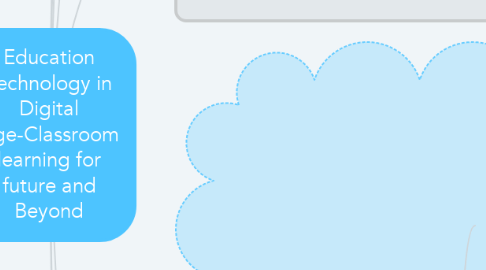
1. Current Scenario of Our Education System
1.1. Nowadays, the Internet and multimedia technology uses in different aspects in life have taken place at schools too.
1.1.1. teachers should take courses to help them utilize newer technology in their classrooms.
1.1.1.1. science always adds an inevitable input to the advancement of technology.
1.1.1.1.1. Technology offers better gradesand opportunities for a good job.
1.2. New Type of Teacher and Student
1.2.1. Teachers taking part in remote education must fulfill various essential pre-requisites.
1.2.1.1. Their homes and workplaces should be well equipped.
1.2.1.2. New digital habits must be acquired
1.2.1.3. Teachers should eliminate printed information wherever possible
2. Digital Presence and Digital Futures
2.1. Digital technologies have dramatically encouraged selflearning.
2.1.1. K–12 or institutions of higher learning, are previligazed beacuse of individualized performance in assessments and reward structures
2.1.1.1. But they impede new learning possibilities
2.2. New Digital Culture
2.2.1. There should be a change in all the system
2.2.1.1. Students should learn to manage their leisure and study time
2.2.1.1.1. Stress will be reduced through the time
3. Technology in Today’s Classrooms
3.1. A cheaper and ecological way for everyone.
3.1.1. The transformation of education for the digital natives
3.2. 1. eTexts
3.2.1. online college students can obtain legitimate college degrees without cracking a book– but that doesn’t mean they don’t have to read.
3.2.1.1. 3. Online School Portals
3.3. 2. Virtual Libraries
3.3.1. Students quickly build up their own virtual libraries of thousands of journal articles, even if they are not in the campus.
3.4. 3. Online School Portals
3.4.1. They are so significant an innovation that they could change the future of on campus studies
3.4.1.1. Students can start with one online class per week.
3.5. 4. Webcams & Teleconferencing
3.5.1. Students and teachers could meet each other better.
3.5.1.1. The use of them are easier for them instead of regular classes.
3.6. 5. Mobile Apps & Augmented Reality
3.6.1. AR allows students to point mobile device cams at objects around them.
3.6.1.1. the screen image offers information about what they see. Schools might use them for mobile testing
4. Effects of Technology on Classrooms and Students
4.1. Change in Student and Teacher Roles
4.1.1. students are in an active role, so they can display, manipulate and create new information.
4.1.1.1. Teacher's role plays the role of facilitator, setting project goals and providing guidelines and resources
4.2. Increased Motivation and Self Esteem
4.2.1. Some students are better using technology instead of the regular material, so they feel motivated and good with themselves.
4.2.2. Technical Skills
4.2.2.1. Students will develop their skills by themselves
4.2.2.1.1. that happens by using Outside Resources
4.3. More Collaboration with Peers
4.3.1. together, students and teachers can accomplish more complex tasks
5. Changes That Will Shape The Classroom Of The Future: Making Education Fully Technological
5.1. The layout of the classroom will change immensely.
5.1.1. Seating arrangements in the future will be flexible so that they are appropriate for the task that students are working on
5.1.1.1. Standing desks for students who have difficulty maintaining focus while sitting
5.2. 2. Virtual and augmented reality will change the educational landscape.
5.2.1. Nowadays, pictures can be seen in 3D because there are apps which allow that.
5.3. 3. Flexible assignments will accommodate multiple learning styles.
5.3.1. With flexible assignments, the teacher will be more interested in proof of competency
5.4. MOOCs and other online learning options will impact secondary education.
5.4.1. In the future, students won't waste time learning something that's needed for them.
5.4.1.1. They will receive a diploma just knowing what they like and is needed.
6. Global Trends in ICT and Education
6.1. 1. Mobile Learning.
6.1.1. New advances in hardware and software are making mobile “smart phones” indispensible tools.
6.2. 2. Cloud computing.
6.2.1. Applications are increasingly moving off of the stand alone desktop computer and increasingly onto server farms accessible through the Internet
6.3. 3. One-to-One computing.
6.3.1. The trend in classrooms around the world is to provide an information appliance to every learner and create learning environments that assume universal access to the technology
6.4. 4. Ubiquitous learning.
6.4.1. This trend requires a rethinking of the traditional 40 minute lesson. In addition to hardware and Internet access
6.5. 5. Gaming.
6.5.1. The phenomenal success of games with a focus on active participation, built in incentives and interaction suggests that current educational methods are not falling short
6.6. 6. Personalized learning.
6.6.1. Education systems are increasingly investigating the use of technology to better understand a student’s knowledge base from prior learning
6.7. 7. Redefinition of learning spaces.
6.7.1. Concepts such as greater use of light, colors, circular tables,individual spaces for students and teachers
6.8. 8. Teacher-generated open content.
6.8.1. Many online texts allow teachers to edit, add to, or otherwise customize material for their own purposes
6.9. 9. Smart portfolio assessment.
6.9.1. assessment is increasingly moving toward frequent formative assessments which lend itself to real-time data and less on high pressure exams as the mark of excellence
7. Exploring benefits
7.1. Preparing For the Workforce
7.1.1. Having technological competence gives them a better chance of success in the workforce and gives them a greater ability and confidence to pursue online education university options
7.2. No Student Left Behind
7.2.1. Social Class won't be a negative point for students who come from low classes.
7.3. Quality of Writing
7.3.1. Teachers avoid to use computers, so students write well.However, technology as a replacement for pen and paper is neutral.
7.4. The Danger of Making Technology So Critical
7.4.1. Technology’s Impact on the Future
7.4.1.1. The ability to access information and basic computer literacy can function as a potential stepping-stone out of poverty for many students.
